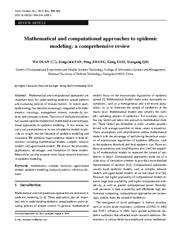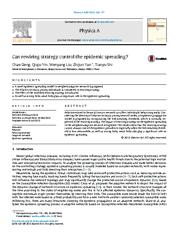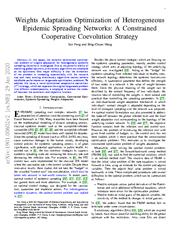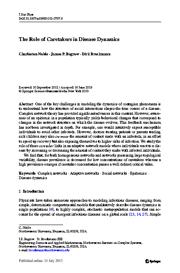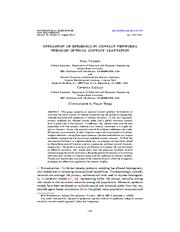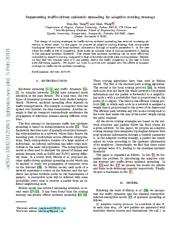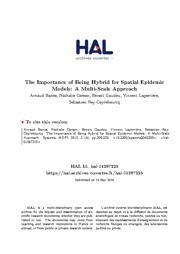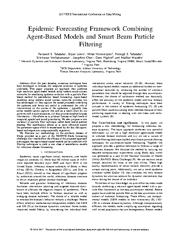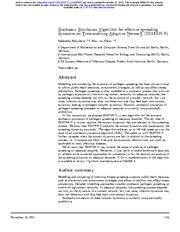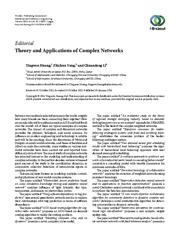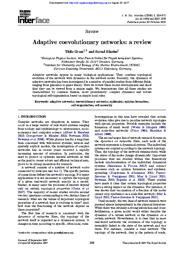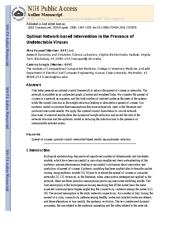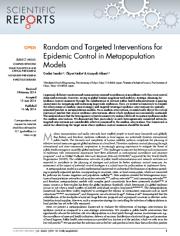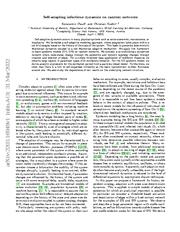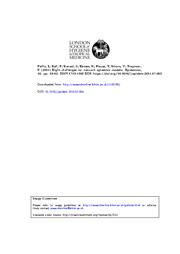A copy of this work was available on the public web and has been preserved in the Wayback Machine. The capture dates from 2020; you can also visit the original URL.
The file type is application/pdf.
Filters
Mathematical and computational approaches to epidemic modeling: a comprehensive review
2015
Frontiers of Computer Science
We introduce major epidemic models in three directions, including mathematical models, complex network models, and agent-based models. ...
Meanwhile, we also propose some future research directions in epidemic modeling. ...
In recent years, many researchers have paid attention to epidemic spread in weighted networks and adaptive networks. ...
doi:10.1007/s11704-014-3369-2
pmid:32288946
pmcid:PMC7133607
fatcat:ceqn6bq22ve6hhgpiau4hwcweu
Can rewiring strategy control the epidemic spreading?
2015
Physica A: Statistical Mechanics and its Applications
The impact of rewiring strategy on the epidemic spreading in the weighted adaptive network is explored. ...
Relation existed in the social contact network can affect individuals' behaviors greatly. ...
proposed the adaptive network to depict the impact of the dynamic change of network structure on epidemic spreading [10] . ...
doi:10.1016/j.physa.2015.06.037
pmid:32288093
pmcid:PMC7126863
fatcat:gxscnq2djvdj5g7uk63xpz3idi
Weights Adaptation Optimization of Heterogeneous Epidemic Spreading Networks: A Constrained Cooperative Coevolution Strategy
[article]
2020
arXiv
pre-print
In this paper, the dynamic constrained optimization problem of weights adaptation for heterogeneous epidemic spreading networks is investigated. ...
One major difficulty is that the dimension of the problem is increasing exponentially with the network size and most existing evolutionary algorithms cannot achieve satisfiable performance on large-scale ...
CONCLUSION In this paper, a dynamic constrained optimization problem of weights adaptation for heterogeneous epidemic spreading networks is formulated. ...
arXiv:1901.00602v2
fatcat:cpby25z7c5brfdjkfrdru4rkea
The Role of Caretakers in Disease Dynamics
2013
Journal of statistical physics
However, awareness of an epidemic in a population typically yields behavioral changes that correspond to changes in the network structure on which the disease evolves. ...
We study the role of these caretaker links in an adaptive network models where individuals react to a disease by increasing or decreasing the amount of contact they make with infected individuals. ...
This is expected, as only regular (negative) interactions exist that decrease in response to the epidemic. The total network weight adapts to a smaller value, decreasing the endemic state. ...
doi:10.1007/s10955-013-0787-8
fatcat:7mjmqlhrkbc5jntimphwzgivxa
Mitigation of epidemics in contact networks through optimal contact adaptation
2013
Mathematical Biosciences and Engineering
Using Pontryagin theorem, the obtained solution is a unique candidate representing the dynamical weighted contact network. ...
In the new approach, contact weighted are reduced among nodes and a global minimum contact level is preserved in the network. ...
The two intertwined dynamic processes, the one related to the epidemic spreading and the other related to the contact network adaptation, act together and impact the epidemic size. ...
doi:10.3934/mbe.2013.10.1227
pmid:23906209
pmcid:PMC3857636
fatcat:fimeayxwcrfbbm4vhxc46dg7wi
Suppressing traffic-driven epidemic spreading by adaptive routing strategy
2016
Chaos, Solitons & Fractals
Moreover, we find that an increase in the average network connectivity and the emergence of traffic congestion can suppress the epidemic outbreak. ...
Despite extensive work on the interplay between traffic dynamics and epidemic spreading, the control of epidemic spreading by routing strategies has not received adequate attention. ...
The third is the efficient routing protocol [36] , in which each node in a network is assigned a weight that is proportional to the power of its degree and The efficient path between any two nodes corresponds ...
doi:10.1016/j.chaos.2016.10.012
fatcat:wmpsnafcdjhflaxn2p2c5om5zq
The Importance of Being Hybrid for Spatial Epidemic Models:A Multi-Scale Approach
2015
Systems
However, when it comes to setting up epidemic control strategies, results rapidly diverge between the two approaches, and it appears that the full macroscopic model is not completely adapted to these questions ...
This work addresses the spread of a disease within an urban system, defined as a network of interconnected cities. ...
Acknowledgments This work was founded by CNRS (Centre National de la Recherche Scientifique) via a PEPS (Projets Exploratoires Premier Soutien) HuMain (Humanités-Mathématiques-sciences de l'Information) in ...
doi:10.3390/systems3040309
fatcat:pjhephm52zbhthg6ku2nwtjgfi
Epidemic Forecasting Framework Combining Agent-Based Models and Smart Beam Particle Filtering
2017
2017 IEEE International Conference on Data Mining (ICDM)
on the course of the epidemics -typically time series models cannot capture this and as a result often do not perform well in such situations; (ii) they provide detailed forecast information -this allows ...
This paper proposes an approach that combines high resolution agent-based models using realistic social contact networks for simulating epidemic evolution with a particle filter based method for assimilation ...
Therefore, adaptive tuner decreases the step size Fig. 2 . Smart state dynamics framework. The feature selector chooses different features from the epidemic curves. ...
doi:10.1109/icdm.2017.145
dblp:conf/icdm/TabatabaLHTVCHM17
fatcat:kur7gbc6zfeldcrpk4o6wp5nye
Stochastic Simulation Algorithm for effective spreading dynamics on Time-evolving Adaptive NetworX (SSATAN-X)
[article]
2021
bioRxiv
pre-print
In adaptive networks, the spreading process depends not only on the dynamics of a contact network, but vice versa, infection dynamics may alter risk behaviour and thus feed back onto contact dynamics, ...
In this manuscript, we propose SSATAN-X, a new algorithm for the accurate stochastic simulation of pathogen spreading on adaptive networks. ...
The funders had no role in designing the research or the decision to publish. ...
doi:10.1101/2021.11.22.469498
fatcat:bllclguhn5favjvt4ywzhwwfea
Theory and Applications of Complex Networks
2014
Mathematical Problems in Engineering
The paper entitled "A new multi-objective evolutionary algorithm for community detection in dynamic complex networks" develops a novel multiobjective algorithm for detecting communities in dynamic networks ...
In the past few decades, we have witnessed great success of the study in the coordination dynamics or cooperative collective behaviors of autonomous agents in complex networks. ...
The paper entitled "A new multi-objective evolutionary algorithm for community detection in dynamic complex networks" develops a novel multiobjective algorithm for detecting communities in dynamic networks ...
doi:10.1155/2014/315059
fatcat:f6hrspz7djfxnljxk56wa2nysa
Adaptive coevolutionary networks: a review
2008
Journal of the Royal Society Interface
Adaptive networks appear in many biological applications. They combine topological evolution of the network with dynamics in the network nodes. ...
Recently, the dynamics of adaptive networks has been investigated in a number of parallel studies from different fields, ranging from genomics to game theory. ...
A first rough attempt at an inventory of dynamics of adaptive networks. Activity disconnects. Rule: frozen nodes gain links, active nodes lose links. ...
doi:10.1098/rsif.2007.1229
pmid:17971320
pmcid:PMC2405905
fatcat:g4g3bccvjncongx5nwtsd2vuka
Optimal Network-Based Intervention in the Presence of Undetectable Viruses
2014
IEEE Communications Letters
Numerical results show the dynamical weight reduction and reveal the role of the network structure and the epidemic model in reducing the infection size in the presence of indiscernible infected nodes. ...
This letter presents an optimal control framework to reduce the spread of viruses in networks. The network is modeled as an undirected graph of nodes and weighted links. ...
The two intertwined dynamic processes, the one related to the epidemic spreading and the other related to the network connectivity adaptation, act together and impact the infection size. ...
doi:10.1109/lcomm.2014.2325026
pmid:25422579
pmcid:PMC4240307
fatcat:t7sw5whgp5efvkzylrrzlyqqya
Random and Targeted Interventions for Epidemic Control in Metapopulation Models
2014
Scientific Reports
A metapopulation model is a useful mathematical framework to understand the dynamics of epidemic spreading in spatially separated patches, corresponding to countries, cities, or local communities, which ...
In general, different countries and communities respond to epidemics in accordance with their own control plans and protocols. ...
Figure 7 | 7 Epidemic interventions in metapopulation models with the Japanese airline network. ...
doi:10.1038/srep05522
pmid:25026972
pmcid:PMC4099978
fatcat:zy3x6iprn5euleclflvfty5ooi
Self-adapting infectious dynamics on random networks
[article]
2022
arXiv
pre-print
Self-adaptive dynamics occurs in many physical systems such as socio-economics, neuroscience, or biophysics. ...
This leads to piecewise deterministic Markovian dynamics coupled to a non-Markovian adaptive mechanism. We apply this framework to basic epidemic models (SIS, SIR) on random networks. ...
In Sec.II we propose a model of strategy adaption. Section III recapitulates SIS and SIR models on networks. In Sec. IV we apply the adaptive framework to SIS and SIR epidemics on networks. ...
arXiv:2203.16949v1
fatcat:2ku67n3xwvcs7ayuke6lfus6sq
Eight challenges for network epidemic models
2015
Epidemics
Here we identify a set of challenges that provide scope for active research in the field of network epidemic models. ...
Even the simplest network epidemic models present unanswered questions. ...
Acknowledgments The authors want to acknowledge the Isaac Newton Institute for Mathematical Sciences, Cambridge, UK, for hosting the Infectious Disease Dynamics programme that resulted in this collaboration ...
doi:10.1016/j.epidem.2014.07.003
pmid:25843385
fatcat:a6cfjc4zmngwvcda6qxius3gme
« Previous
Showing results 1 — 15 out of 27,563 results

